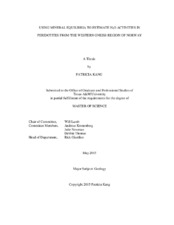| dc.description.abstract | The earth’s mantle is an important reservoir of H2O, and even a small amount of H2O has a significant influence on the physical properties of mantle rocks. Estimating the amount of H2O in rocks from the earth’s mantle would, therefore, provide some insights into the physical properties of this volumetrically dominant portion of the earth. The goal of this study is to use mineral equilibria to determine the activities of H2O (aH2O) in samples derived from the mantle. Two different approaches are applied to estimate H2O activities in orogenic mantle peridotites from the Western Gneiss Region of Norway. The first approach uses amphibole dehydration equilibrium as described by Lamb and Popp (2009). The second approach is to estimate the minimum value of aH2O by characterizing fluid speciation in C-O-H system for a given value of oxygen fugacity (ƒO2). Values of ƒO2 were estimated from a ƒO2-buffering reaction between olivine, orthopyroxene, and spinel (Wood, 1990). Our results show that the estimate of aH2O obtained from the amphibole dehydration equilibrium is significantly lower than that estimated from the C-O-H calculation. This indicates that fluid pressure (Pfluid) is less than lithostatic pressure (Plith) which, for metamorphic rocks, implies the absence of a free fluid phase.
Fluid absent condition could be generated by amphibole growth during exhumation. If small amounts of H2O were added to these rocks, the formation of amphibole could yield low values of aH2O by consuming all available H2O. On the other hand, if H2O infiltrated at P-T conditions outside of the stability field of amphibole, the nominally anhydrous minerals (NAMs) might have served as a reservoir of H2O. In this case, NAMs could supply the OH necessary for amphibole growth once retrograde P-T conditions were consistent with amphibole stability. Thus, amphibole growth may effectively dehydrate co-existing NAMs, and enhance the strength of rocks as long as the NAMs controlled the rheology of the rock.
Fluid absent condition could be generated by amphibole growth during exhumation. If small amounts of H2O were added to these rocks, the formation of amphibole could yield low values of aH2O by consuming all available H2O. On the other hand, if H2O infiltrated at P-T conditions outside of the stability field of amphibole, the nominally anhydrous minerals (NAMs) might have served as a reservoir of H2O. In this case, NAMs could supply the OH necessary for amphibole growth once retrograde P-T conditions were consistent with amphibole stability. Thus, amphibole growth may effectively dehydrate co-existing NAMs, and enhance the strength of rocks as long as the NAMs controlled the rheology of the rock. | en |


